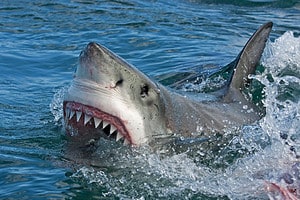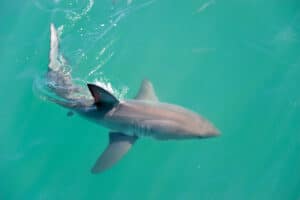Being an island country, The Bahamas have many rich and diverse marine habitats. The waters of The Bahamas are one of the world’s most popular places to spot sharks. These shark-rich waters provide the perfect opportunity for anyone who wants to get up close to these predators of the sea. That said, f you are too wary of seeing sharks in the wild, many diving tours are available for you to shark-watch safely!
Here are 9 species of shark that can be found in The Bahamas.

1. Oceanic Whitetip Shark (Carcharhinus longimanus)
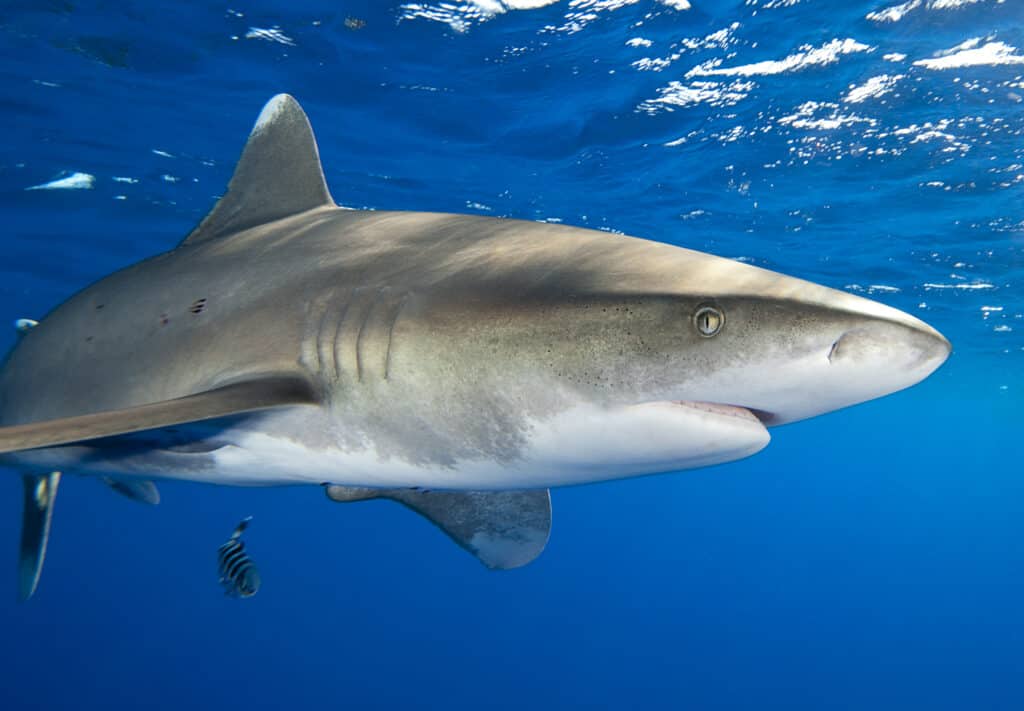
This shark has a white tip on its fin that gives it its name.
©A Cotton Photo/Shutterstock.com
The oceanic whitetip shark inhabits tropical and warm temperate seas. These sharks have stocky bodies with long fins. The most distinguishing feature of the oceanic whitetip shark is its fins – both its pectoral and dorsal fins are big and rounded. The snout of the shark is rounded, and the eyes are circular. As the name of the shark suggests, oceanic whitetip sharks have white tips on most of their fins. There can also be some mottling on the fins. Dorsally, the shark is gray-bronze; ventrally, the shark is white. The oceanic whitetip shark generally grows up to 13 feet long and can weigh as much as 370 lbs.
These sharks are found worldwide and inhabit deep, open oceans. They prefer temperatures over 68 F, meaning The Bahamas is the perfect home for these predators. The oceanic whitetip shark’s diet varies as it is an opportunistic predator. The prey that these sharks mostly consume is bony fish. They may also eat birds, crustaceans, and stingrays. Because they are opportunistic, these sharks are known for their aggressive nature, so do not provoke or spook them, as this may lead to an attack.
2. Tiger Shark (Galeocerdo cuvier)
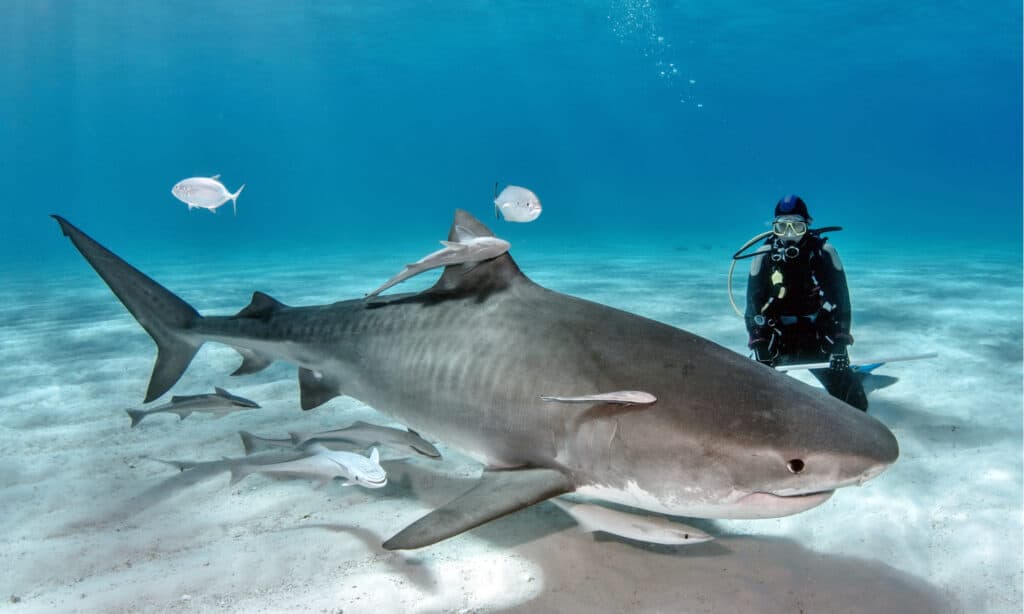
One of the most aggressive and largest shark species is the
tiger
shark.
©Tomas Kotouc/Shutterstock.com
The tiger shark is the fourth largest shark in the world and is commonly known as the leopard shark, maneater Shark, and spotted Shark. These ferocious predators can grow over to over 13 feet long and weigh well over 1,400 pounds. Tiger sharks get their name from the distinctive dark stripes around their bodies that fade as they get older. The dorsal aspect of the shark is gray, while the ventral aspect is white. Their teeth are pointed sideways, which helps them to slice through tough prey.
Tiger sharks inhabit warm tropical waters such as the coastal regions of the North Atlantic Ocean and especially in the waters surrounding the Bahamas. They prefer shallow coastal waters as much of their prey is found here. The diet of tiger sharks consists of fish, dolphins, seals, sea turtles, and more. As apex predators, these sharks do not have to worry about becoming prey themselves.
3. Caribbean Reef Shark (Carcharhinus perezii)
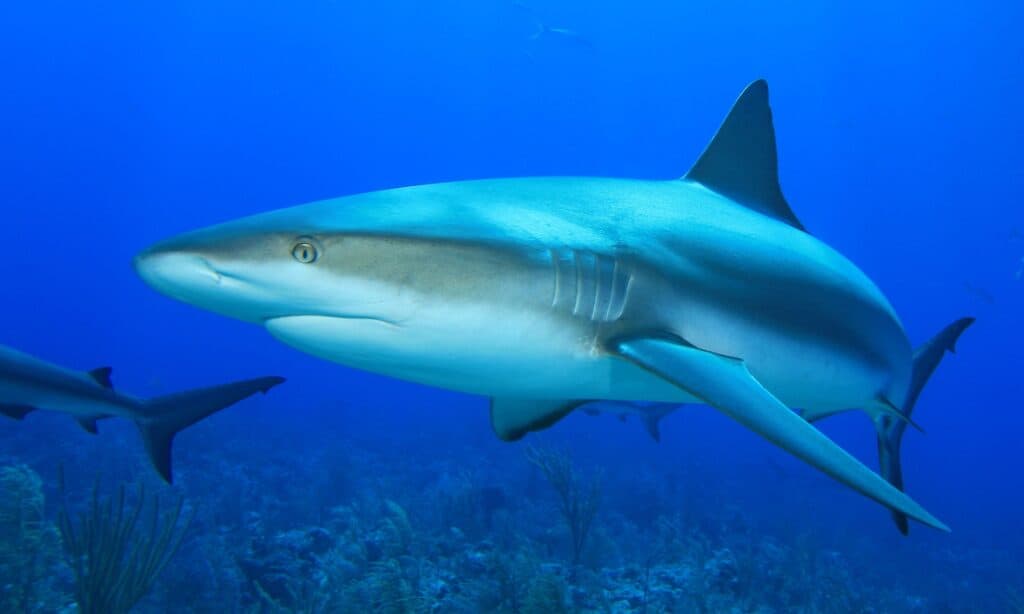
This species doesn’t have many unique markings, so it is more difficult to identify than other species.
©iStock.com/richcarey
The Caribbean reef shark is a heavy-bodied shark that is found in shallow waters around coral reefs. These sharks can grow between 6.5 and 8.2 feet in length and weigh around 150 pounds. The snouts of these sharks are short and wide, while their eyes are round and large. These sharks have a distinctive white stripe on their flanks. The color on their dorsal side is generally gray-brown or dark gray, while the ventral side is white.
The Caribbean reef shark inhabits warm waters, in particular the Caribbean Sea. They are the most common shark in The Bahamas, and divers commonly spot them at popular diving spots around the islands. These sharks are apex predators in the reef system and are vital to coral reef communities. The diet of these sharks is mainly reef-dwelling animals that include octopuses, bony fish, crabs, and more. Thankfully, these sharks are not known to be aggressive to humans and are very valuable in ecotourism.
4. Bull Shark (Carcharhinus leucas)
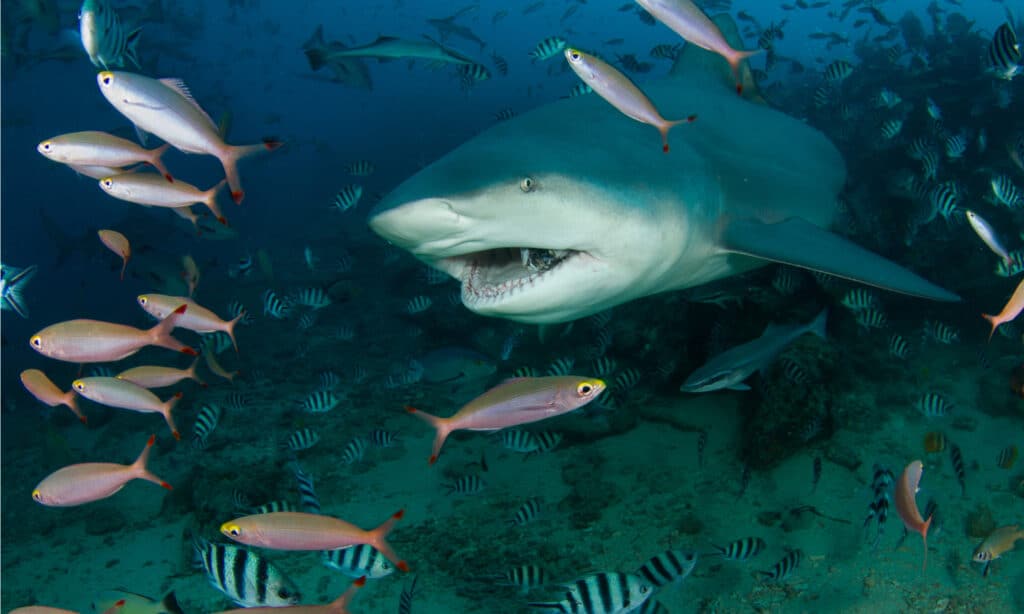
Although they are not a true freshwater sharks, bull sharks can survive in freshwater for very long periods.
©chatchai kusolsinchai/Shutterstock.com
The bull shark is a species of shark that is known for its aggressive nature. This species is large and can grow between 7 and 11.5 feet in length and weigh up to 500 pounds. Their bodies are stout, and their noses are blunt. Bull sharks are gray dorsally and white ventrally. The teeth are triangular with serrated edges – perfect tools for hunting.
Interestingly, bull sharks can survive in both freshwater and seawater. That said, they are not truly freshwater fish. They can, however, survive in freshwater for a very long time. They like to inhabit warm, shallow coastal waters like the ones The Bahamas provide. These apex predators generally eat fish, dolphins, other sharks, and more. Bull sharks are large predators that do not fall prey to other animals.
5. Lemon Shark (Negaprion brevirostris)
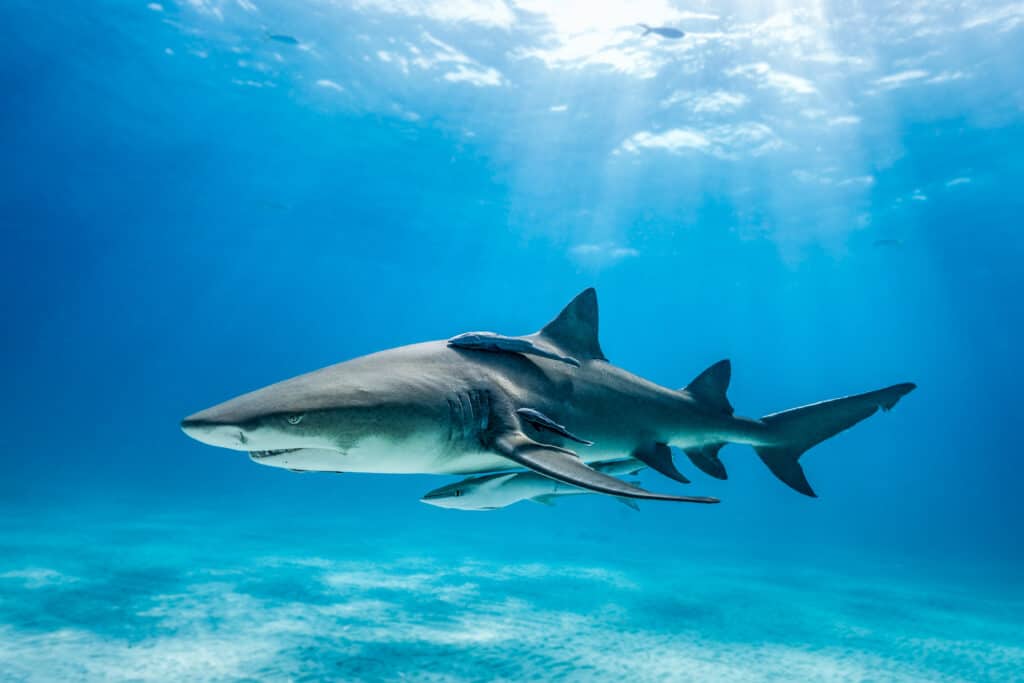
A medium sized shark that can be found in the Bahamas is the lemon shark.
©iStock.com/Michael Geyer
The lemon shark has a slightly yellow coloration, which is where it gets its name. The coloration of the shark helps it to blend into the sandy floor, which helps evade predators and helps to catch prey. These sharks will grow between 7.9 and 10.2 feet in length and weigh around 200 pounds. They have flat heads with short and broad snouts.
These amazing sharks prefer to live in waters no deeper than 188 feet and can be found in the tropical waters surrounding the Bahamas. The lemon shark’s diet mainly consists of fish, but when the opportunity comes, they will also feed on smaller sharks and crustaceans. You can find these sharks in locations such as coral reefs and enclosed bays where they will do most of their hunting – the Tiger Beach in the Bahamas is a great place to spot these sharks.
6. Nurse Shark (Ginglymostoma cirratum)
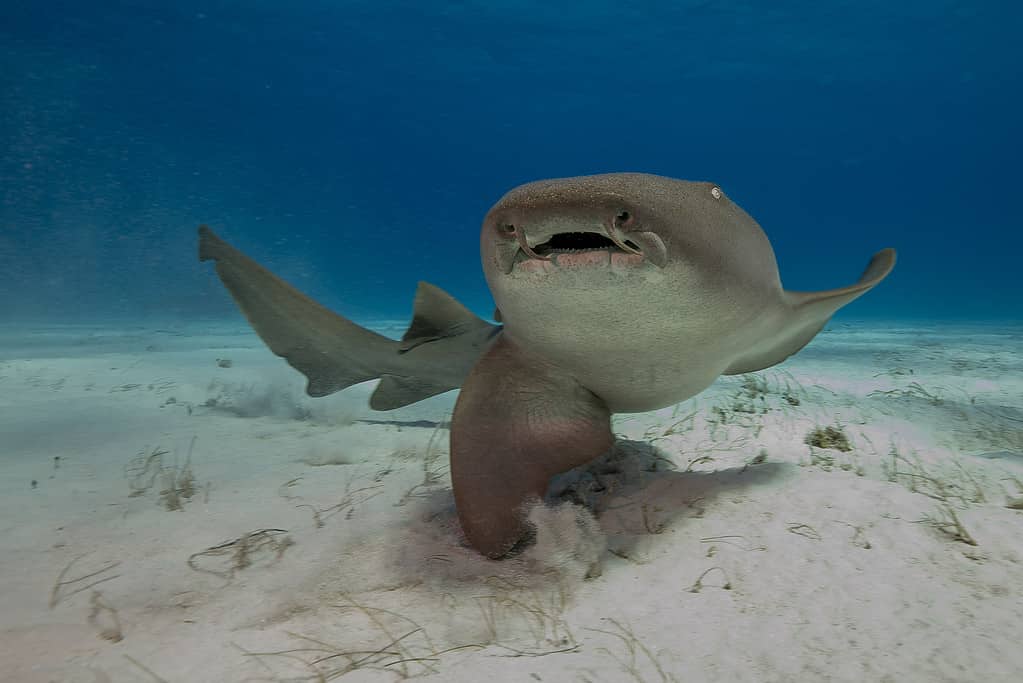
Growing to only around 8 feet, nurse sharks are a relatively small shark species.
©Stevelaycock21 / CC BY-SA 4.0 – License
Nurse sharks are smaller sharks that grow around 8 feet in length and weigh over 200 pounds. These sharks have a tan to dark brown coloration. In younger sharks, there is skin mottling with dark patches surrounded by a lighter border around each spot. However, this mottling fades with maturity. These sharks also have a pair of barbels that extend from their snout to locate prey.
Nurse sharks are generally found resting on the ocean floor during the day. They inhabit areas such as shallow reefs and mangroves where there is plentiful prey. These sharks hunt mostly at night and prey on crustaceans, fish, stingrays, mollusks, and more. Luckily, nurse sharks are not aggressive toward humans and will not attack unless provoked.
7. Great Hammerhead Shark (Sphyrna mokarran)
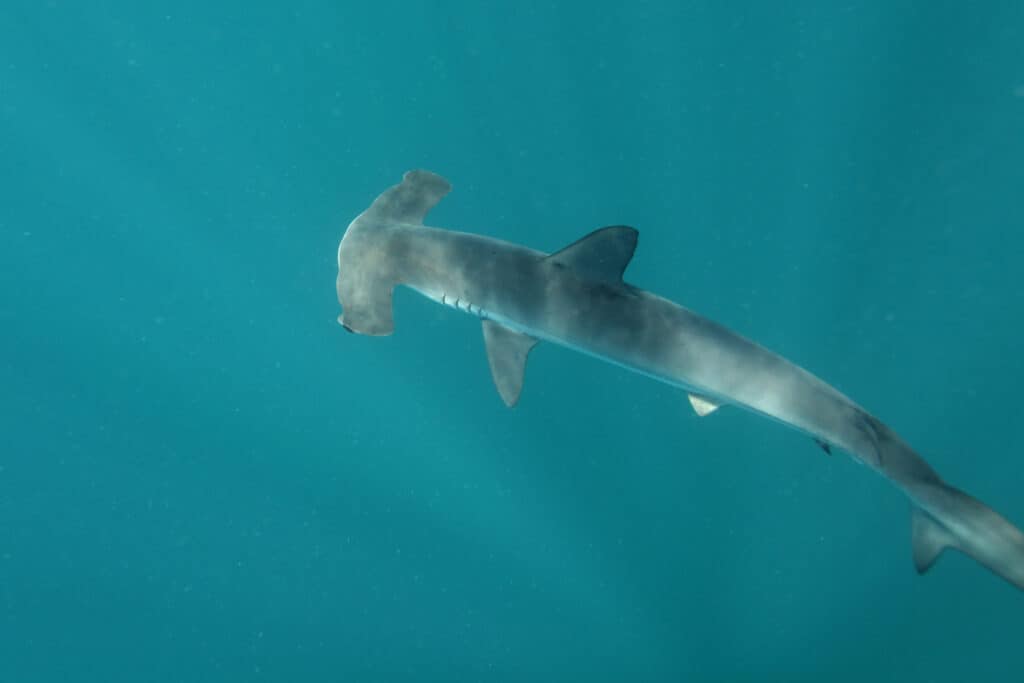
Hammerheads can be found in coastal areas of the Bahamas.
©Alessandro De Maddalena/Shutterstock.com
Great hammerhead sharks inhabit many of the world’s oceans, including the Atlantic, Indian, and Pacific Oceans, as well as the Mediterranean Sea. They are also often found in the coastal waters of The Bahamas. Great hammerhead sharks are easily identifiable due to their unique T-shaped heads. With eyes on each end of the head, these sharks have great peripheral vision making them excellent hunters. They are grayish-brown dorsally and cream-colored ventrally. These sharks have an average length of around 13 feet long and weigh around 500 pounds.
There are many dedicated diving tours specializing in great hammerhead shark encounters. The most popular dive sites are in Bimini. These sharks can be seen in waters as shallow as 3.3 feet down to a depth of 260 feet. Their preferred place to roam is among coral reefs, island terraces, and lagoons. This is because there is ample prey for them to hunt in these areas. Their prey consists of marine life near the seafloor, such as stingrays, octopuses, squid, crustaceans, and even other sharks.
8. Silky Shark (Carcharhinus falciformis)
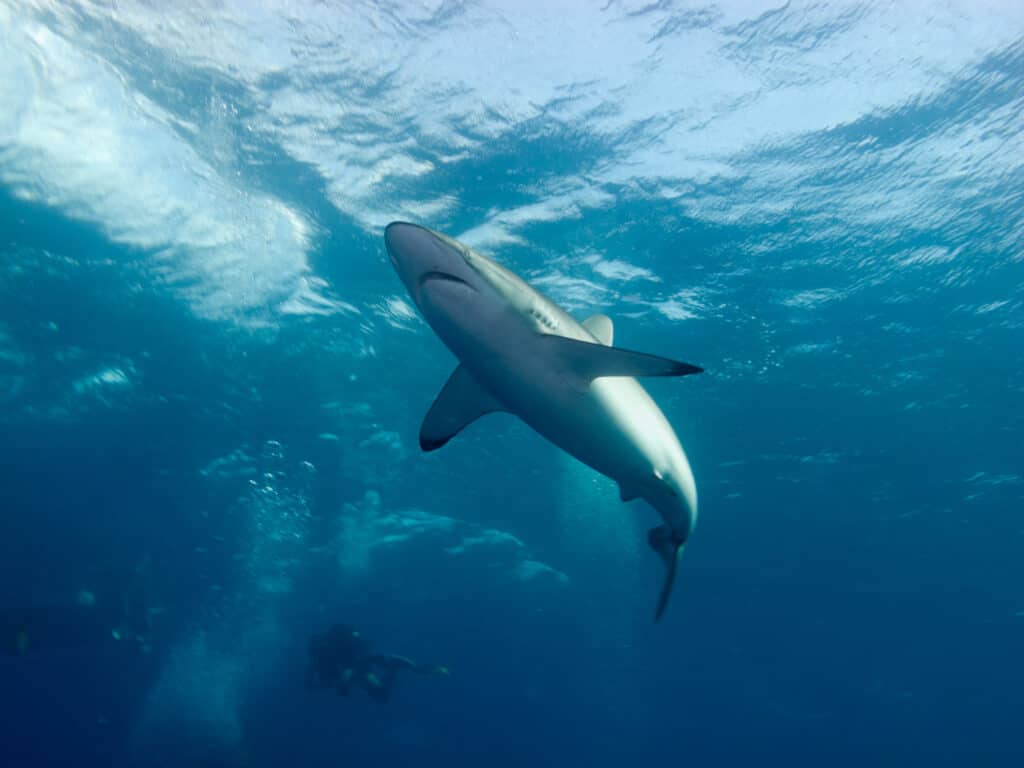
Another common shark species in the Bahamas is the silky shark.
©Sergey Dubrov/Shutterstock.com
The silky shark inhabits many of the world’s tropical oceans, including The Bahamas. These sharks have long and slender bodies and will grow to be around 8 feet long. Their name comes from the smooth texture of the shark’s skin. Their dorsal aspect is blueish-gray, while their ventral aspect is white. Silky sharks can be easily identified due to their small dorsal and secondary dorsal fins.
Silky sharks prefer the warmer waters of tropical oceans and can be found anywhere between the surface of the water and at depths down to 1,550 feet. They are most commonly found at around the 650 feet mark. They are usually seen in and around continental shelves. The most popular places in The Bahamas to spot these sharks is at Cat Island, Andros, and the Lost Blue Hole in Nassau. Silky sharks feed on a variety of marine life, including bony fish, octopus, squid, and mackerel. However, tuna is the favorite meal of this shark.
9. Whale Shark (Rhincodon typus)
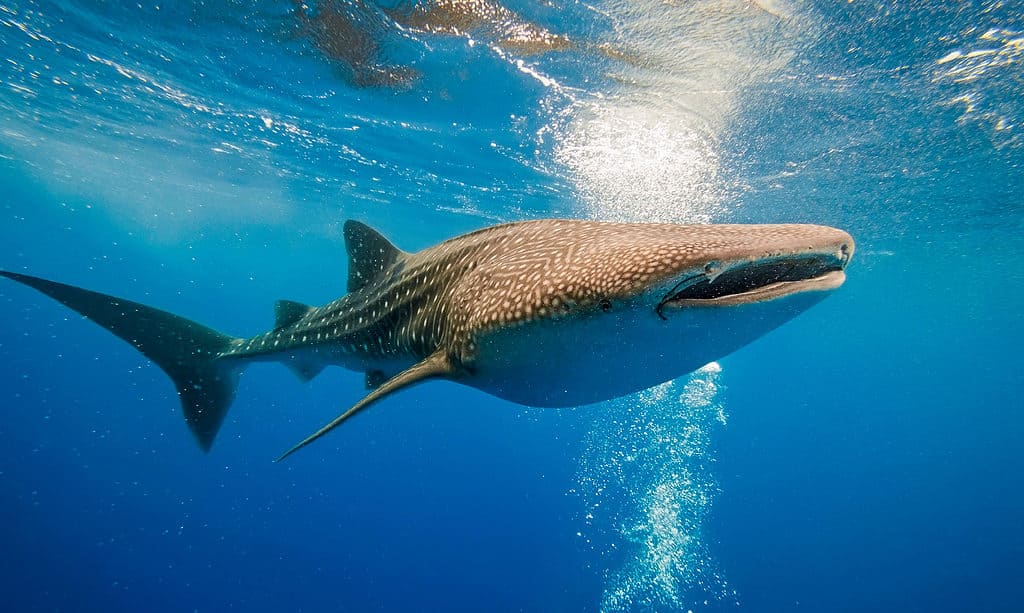
The largest fish in the world by quite some margin is the whale shark.
©Krzysztof Odziomek/Shutterstock.com
The whale shark is an enormous fish – in fact, it is the largest existing fish species. The underside of the Whale Shark is white, while the upper half is dark gray. They can be covered in lighter-colored spots or stripes. These sharks can grow to be around 39 feet in length and weigh about 41,000 pounds. Incredibly, their mouths can be up to 4 feet wide! It’s no wonder this shark’s name relates it to the largest animal in the world!
Whale sharks are most commonly found in warm tropical waters, both deep and shallow. They can also be found around coral atolls and reefs where there is a higher chance of finding food. Being filter feeders, they use special filtering pads inside their mouths to catch prey. They can gulp water at such a high velocity that not many of their targets can escape. These incredible sharks can filter up to 1,500 gallons per hour. Their prey includes plankton, fish eggs, and any other small marine life that can get caught in these filters.
Where to Spot Sharks in The Bahamas
There are many different places around the islands of The Bahamas to spot sharks, thanks to the bountiful surrounding ocean. Cat Island, Tiger Beach, and Bimini are the most popular places for people to get the full shark-sighting experience. The chances to see any one particular shark vary throughout the year and even the time of day! However, you will find that Caribbean reef sharks are present year-round, so there is always a shark to see.
Shark Attacks in The Bahamas
Unfortunately, there have been at least 32 shark attacks on humans in The Bahamas since 1749. The most recent attack resulted in a woman losing her leg after she was attacked by a shark while scuba diving. A shark bit her, but she managed to fend it off, then made her way back to the boat. Later, when she was in the hospital, surgeons decided to amputate the leg due to infection. It is always important to realize that shark attacks can and do occur. Always be cautious when you encounter any shark, as you never know what may set them off. Ensure to create distance between yourself and the shark and only observe them underwater in a safe environment.
Summary of Sharks Found in The Bahamas
| Number | Shark | Scientific Name |
|---|---|---|
| 1 | Oceanic Whitetip Shark | Carcharhinus longimanus |
| 2 | Tiger Shark | Galeocerdo cuvier |
| 3 | Caribbean Reef Shark | Carcharhinus perezii |
| 4 | Bull Shark | Carcharhinus leucas |
| 5 | Lemon Shark | Negaprion brevirostris |
| 6 | Nurse Shark | Ginglymostoma cirratum |
| 7 | Great Hammerhead Shark | Sphyrna mokarran |
| 8 | Silky Shark | Carcharhinus falciformis |
| 9 | Whale Shark | Rhincodon typus |
The photo featured at the top of this post is © Krzysztof Odziomek/Shutterstock.com
Thank you for reading! Have some feedback for us? Contact the AZ Animals editorial team.



